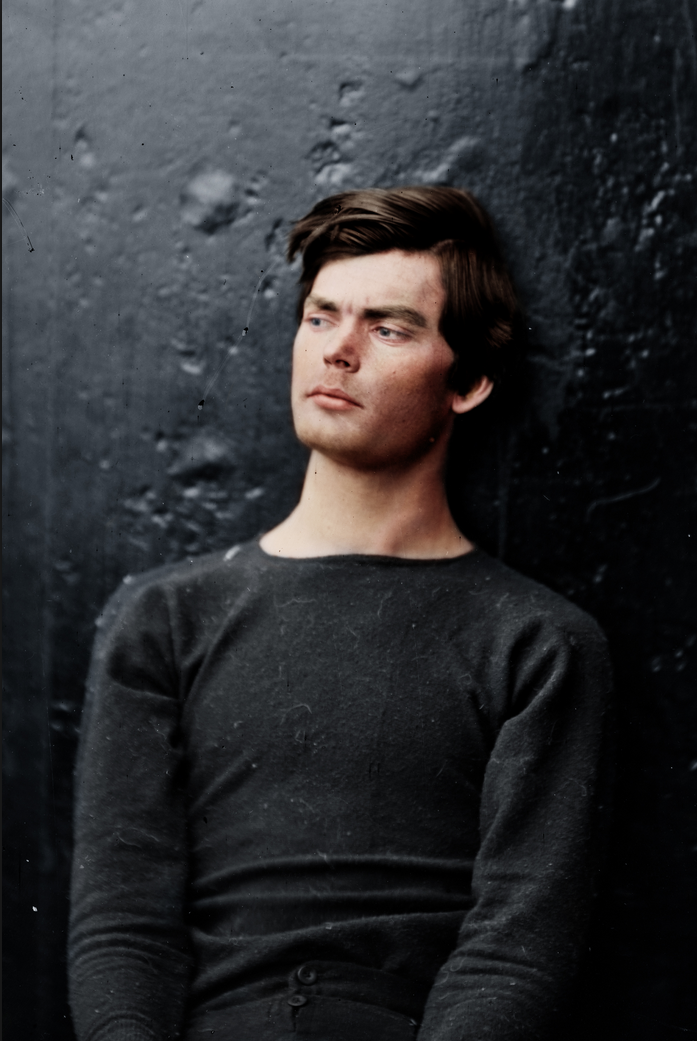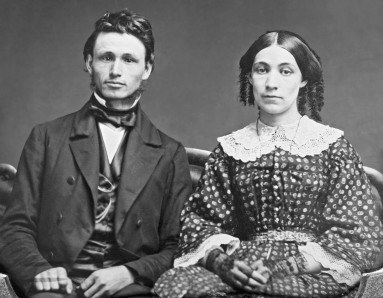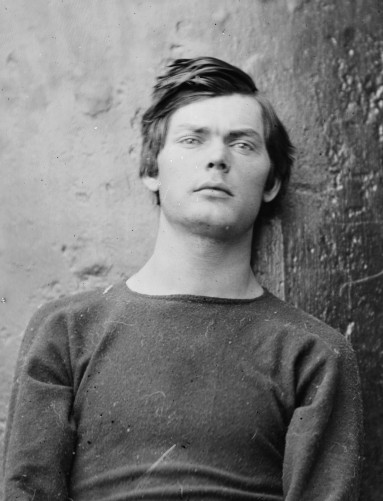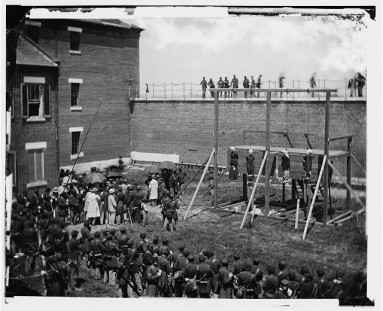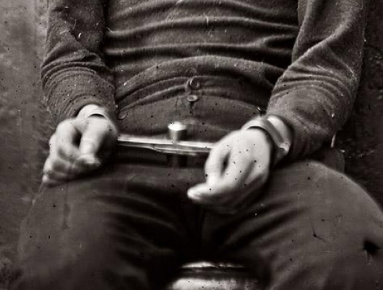The famous photographs of Lincoln assassination co-conspirator Lewis Powell show modern self-consciousness being born before an indifferent lens
It’s not uncommon to hear someone say that they were haunted by an image, often an old photograph. It is a figurative and evocative expression. To say that an image is haunting is to say that the image has lodged itself in the mind the way a ghost might stubbornly take up residence in a house, or that it has somehow taken hold of the imagination and lives on there as a spectral after-image. When we speak of images of the deceased, of course, the language of haunting approaches literalness. In these photographs, the dead enjoy an afterlife in the beholder's imagination.
When I came upon the image of Powell above in a series of recently colorized Civil War photographs, I was immediately captivated by its apparent modernity. Nineteenth century photographs tend to have a distinct feel, one that clearly announces the distant “pastness” of what they have captured. That they are ordinarily black-and-white only partially explains this effect. More significantly, the effect is communicated by the look of the people in the photographs — not their physical appearance, though; rather, it’s the “look” of their personality.
There is distinct subjectivity — or, perhaps, lack thereof — that emerges from most old photographs. There is something in the eyes that suggests a way of being in the world that is foreign and impenetrable to us. The camera itself seems to be a double cause of this dissonance. First, the subjects seem unsure of how to position themselves before the camera; they are still unsettled, it seems, by the photographic technique. They also seem to be wrestling with the camera’s gaze. They are too aware of it. It has rendered them objects, and they’ve not yet managed to negotiate the terms under which they may recover their status as subjects in their own right. In short, they had not yet grown comfortable playing themselves before the camera or with the self-alienated stance that such performance entails.
But then there is this image of Powell, which looks as if it could have been taken yesterday and posted on Instagram. The gap in consciousness seems entirely closed. The “pastness” is eclipsed. Was this merely a result of his clean-shaven, youthful air? Was it the temporal ambiguity of his clothing or of the way he wore his hair? Or was Powell on to something that his contemporaries had not yet grasped? Did his image hold some clue about the evolution of modern consciousness? I went in search of an answer, and I found that the first person I turned to had been there already.
Roland Barthes’s discussion of death and photography in Camera Lucida has achieved canonical status, so I turned to his analysis in order to shed light on my experience of this particular image that was so weighted with death. I soon discovered that an image of Powell appears in Camera Lucida. It is not the same image that grabbed my attention, but a similar photograph taken at the same time. In this photograph, Powell is looking at the camera, the manacles that bind his hands are visible, but still the modernity of expression persists.
Barthes was taken by the way that a photograph suggests both the “that-has-been” and the “this-will-die” aspects of a photographic subject. His most famous discussion of this dual gesture involved a photograph of his mother, which does not appear in the book. But a shot of Powell is used to illustrate a very similar point. It is captioned, “He is dead, and he is going to die …” The photograph simultaneously witnesses to three related realities. Powell was, he is no more, and in the moment captured by this photograph, he is on his way to death.
Barthes also repurposed two Latin words for his analysis: studium and punctum. The studium of a photograph is its ostensible subject matter and what we might imagine the photographer seeks to convey through the photograph. The punctum by contrast is the aspect that “pricks” or “wounds” the viewer. The experience of the punctum is wholly subjective. It is the aspect of a photograph that disturbs the studium and jars the viewer. Regarding the Powell photograph, Barthes writes,
The photograph is handsome, as is the boy: that is the studium. But the punctum is: he is going to die. I read at the same time: this will be and this has been; I observe with horror an anterior future of which death is the stake. By giving me the absolute past of the pose, the photograph tells me death in the future. What pricks me is the discovery of this equivalence.
In my own experience, the studium was already the awareness of Powell’s impending death. The punctum was the modernity of Powell’s subjectivity. Still eager to account for the photograph’s effect, I turned from Barthes to historical sources that might shed light on the photographs.
***
The night of the assassination attempt, Powell entered the Seward residence claiming that he was asked to deliver medicine for Seward. When Seward’s son, Frederick, told Powell that he would take the medicine to his father, Powell handed it over, started to walk away, but then wheeled on Frederick and put a gun to his head. The gun misfired and Powell proceeded to beat Frederick over the head with it. He did so with sufficient force to crack Frederick’s skull and jam the gun.
Powell then pushed Seward’s daughter out of the way as he burst into the secretary of state’s room. He leapt onto Seward’s bed and repeatedly slashed at Seward with a knife. Seward was likely saved by an apparatus he was wearing to correct an injury to his jaw sustained days earlier. The apparatus deflected Powell’s blows from Seward’s jugular. Powell then wounded two other men, including another of Seward’s sons, as they attempted to pull him off of Seward. As he fled down the stairs, Powell also stabbed a messenger who had just arrived. Like everyone else who was wounded that evening, the messenger survived, but he was paralyzed for life.
Rushing outside, Powell discovered that a panicky co-conspirator who was to help him make his getaway had abandoned him. Over the course of three days, Powell then made his way to a boardinghouse owned by Mary Surratt where Booth and his circle had plotted the assassinations. He arrived, however, just as Surratt was being questioned, and, not providing a very convincing account of himself, he was taken into custody. Shortly thereafter, Powell was picked out of a lineup by one of Seward’s servants and taken aboard the ironclad USS Saugus to await his trial.
It was aboard the Saugus that Powell was photographed by Alexander Gardner, a Scot who had made his way to America to work with Matthew Brady. According to Powell’s biographer, Betty Ownsbey, Powell resisted having his picture taken by vigorously shaking his head when Gardner prepared to take a photograph. Given the exposure time, this would have blurred his face beyond recognition. Annoyed by Powell’s antics, H. H. Wells, the officer in charge of the photo shoot, struck Powell’s arm with the side of his sword. At this, Major Eckert, an assistant to the secretary of war who was there to interrogate Powell, interposed and reprimanded Wells.
Powell then seems to have resigned himself to being photographed, and Gardner proceeded to take several shots of Powell. Gardner must have realized that he had something unique in these exposures because he went on to copyright six images of Powell. He didn’t bother to do so with any of the other pictures he took of the conspirators. Historian James Swanson explains
[Gardner’s] images of the other conspirators are routine portraits bound by the conventions of 19th century photography. In his images of Powell, however, Gardner achieved something more. In one startling and powerful view, Powell leans back against a gun turret, relaxes his body, and gazes languidly at the viewer. There is a directness and modernity in Gardner’s Powell suite unseen in the other photographs.
My intuition was re-affirmed, but the question remained: What accounted for the modernity of these photographs?
***
Ownsbey’s account of the photo shoot contained an important clue: Powell’s subversive tactics. Powell clearly intuited something about his position before the camera that he didn’t like. He attempted one form of overt resistance but appears to have decided that this choice was untenable. He then seems to acquiesce. But what if he wasn’t acquiescing? What if the modernity that radiates from these pictures arises out of Powell’s continued resistance by other means?
Powell could not avoid the gaze of the camera, but he could practice a studied indifference to it. In order to resist the gaze, he would carry on as if there were no gaze. To ward off the objectifying power of the camera, he had to play himself before the camera. Simply being himself was out of the question; the observer effect created by the camera’s presence so heightened one’s self-consciousness that it was no longer possible to simply be. Simply being assumed self-forgetfulness. The camera does not allow us to forget ourselves. In fact, as with all technologies of self-documentation, it heightens self-consciousness. In order to appear indifferent to the camera, Powell had to perform the part of Lewis Powell as Lewis Powell would appear were there no camera present.
In doing so, Powell stumbled upon the negotiated settlement with the gaze of the camera that eluded his contemporaries. He was a pioneer of subjectivity. Before the camera, many of his contemporaries either stared blankly, giving the impression of total vacuity, or else they played a role–the role of the brave soldier, or the statesman, or the lover, etc. Powell found another way. He played himself. There was nothing new about playing a role, of course. But playing yourself, that seems a watershed of consciousness. Playing a role entails a deliberate putting on of certain affectations; playing yourself suggests that there is nothing to the self but affectations. The anchor of identity in self-forgetfulness is lifted and the self is set adrift. Perhaps the violence that Powell had witnessed and perpetrated prepared him for this work against his psyche.
If indeed this was Powell’s mode of resistance, it was Pyrrhic: Ultimately it entailed an even more profound surrender of subjectivity. It internalized the objectification of the self that the external presence of the camera elicited. This is what gave Powell’s photographs their eerie modernity. They were haunted by the future, not the past. It wasn’t Powell’s imminent death that made them uncanny; it was the glimpse of our own fractured subjectivity. Powell’s struggle before the camera, then, becomes a parable of humanness in the age of pervasive documentation. We have learned to play ourselves with ease, and not only before the camera. The camera is now irrelevant.
In the short time that was left to him after the Gardner photographs were taken, Powell went on to become a minor celebrity. He was, according to Swanson, the star attraction at the trial of Booth’s co-conspirators. Powell “fascinated the press, the public, and his own guards.” He was, in the words of a contemporary account, “the observed of all observers, as he sat motionless and imperturbed, defiantly returning each gaze at his face and person.” But the performance had its limits. Although Ownsbey has raised reasonable doubts about the claim, it was widely reported that Powell had attempted suicide by repeatedly pounding his head against a wall.
On July 7, 1865, a little over two months since the Gardner photographs, Powell was hanged with three of his co-conspirators. It doesn’t require Barthes’s critical powers to realize that death saturates the Powell photographs, but death figures only incidentally in the reading I’ve offered here. It is not, however, irrelevant that this foray into modern consciousness was undertaken under the shadow of death. It is death, perhaps, that gave Powell’s performance its urgency. And perhaps it is now death that serves as the last lone anchor of the self.

